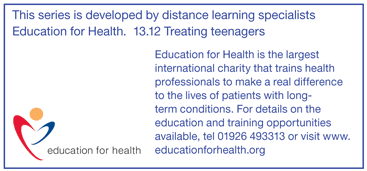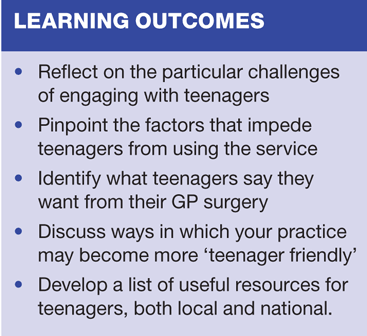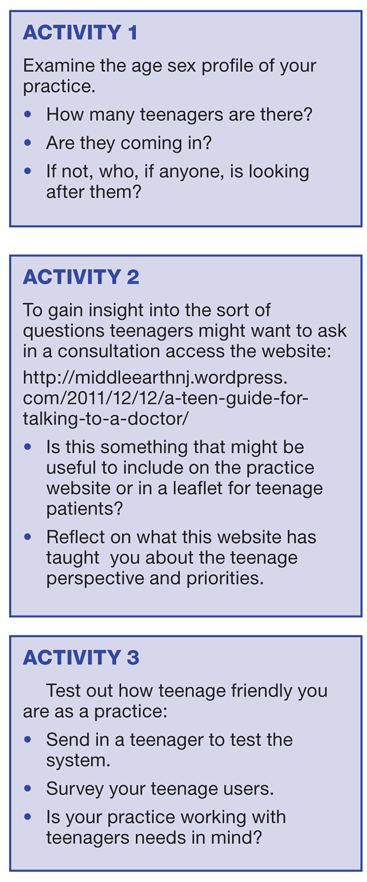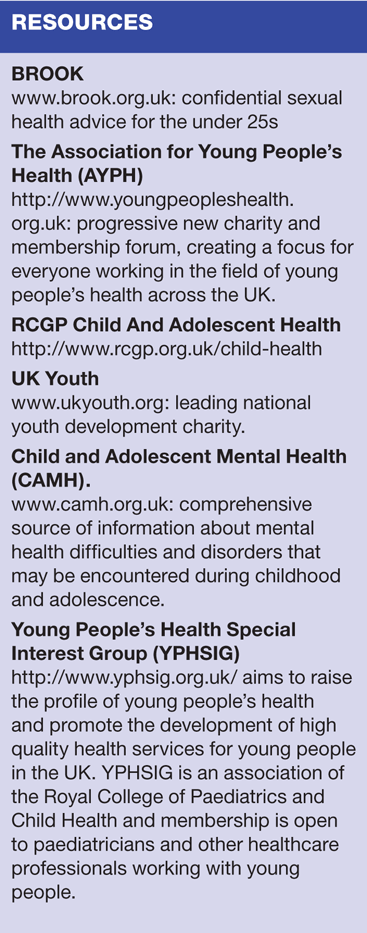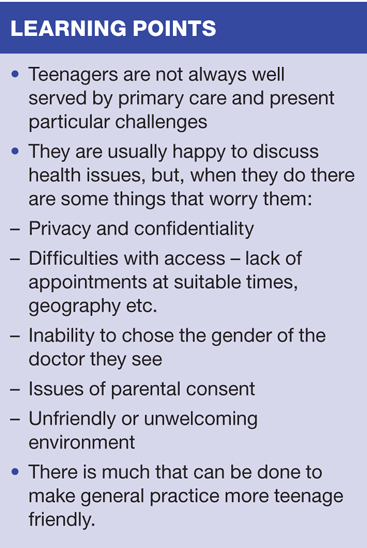Treating teenagers
Dr Mary Lowth
Dr Mary Lowth
MA MB BChir FRCGP PCGME
GP, MRCGP examiner and
medical educator
Teenagers are a group that needs special nurturing. Somewhere between childhood and adulthood, with features of both and of neither, they present specific challenges to the practice nurse
Practice nurses have many opportunities to engage with teenagers. It is, however, a common perception that teenagers consult seldom in general practice. Statistics refute this perception; in reality the average teen consults two-to-three times per year.1 Our opportunity to engage with this group of patients is there. If we feel we don't see them then perhaps we are simply not grasping the available opportunities.
WHAT IS A TEENAGER?
Teenagers are people in transit between childhood and adulthood. Anyone who has ever been stuck in an airport will recognise that transit is an uncomfortable place, designed entirely for waiting to go somewhere else. Until we spend time talking to teenagers we will not know where they have got to in the series of changes that make up the 'transit lounge' of adolescence.
We can make some generalisations, but, at the very least, we need to understand the need to adjust our style of engagement to them, rather than insist that they turn themselves into either a child or an adult for the purposes of their engagement with us.
THE CHALLENGE FOR TEENAGERS
The teenage years are generally the first time in their life that an individual will get to talk to a doctor and nurse alone, and be in a position to make choices about their healthcare.2 However, teenagers don't yet know the etiquette of the consultation. Why should they know they have ten minutes unless we tell them? How do they know they can have a chaperone that isn't their mother unless we make it explicit?
Teenagers live in a world of mixed signals: adults may sometimes treat them as a child and sometimes as an adult — often when it suits the adult's purposes. When people are treated inconsistently their response is likely to be inconsistent too.
Many teenagers say that adults simply don't know what it's like to be a teenager these days. They feel we are alien to them. Even our language shows subtle differences. They don't accept that we understand their world and we need to recognise that they feel different.
Teenagers get their information from other teenagers. This may have misinformed them about many aspects of the way primary care is delivered and they lack the life experience to judge what is likely to be true.
CHALLENGES FOR US
Dealing with an autonomous patient who is not an adult tests our communication skills, and we need to tailor our discussions to the patient.2 Apart from judging competence and capacity (Box 1), we need to assess the extent to which they want to talk, their level of maturity and their areas of immaturity.
Practices may not be teenager friendly. Practices will have evolved their own systems for patient access but may not always have communicated these well, particularly to a group who may be accessing a practice independently for the first time.
Practices look busy and talk a lot about emergencies. This can mean that, in the eyes of the teenager, we behave as though we have more important issues to deal with than their problems. Teenaged patients are more likely than most to give up and never return.
BUFFY THE VAMPIRE SLAYER3
This is not a heading you will see very often in Practice Nurse! This TV series ran for many years, and in its wake has come a trail of teenage vampire movies. If you have ever delved into this genre you will know that there are particular characteristics of teenage cinematic fiction. Indeed the show's writer said that elements in the series stood as metaphors for personal anxieties associated with adolescence.4
There are some common themes. Teenagers are the heroes (and villains) without the involvement of adults as central figures at all. There may be one adult 'guru' who 'gets it', but most adults are uninformed. There are crises that only teenagers understand, and they can only talk to other teenagers about. Adults occupy another world and could not possibly understand. Moreover, adults simply don't realise how serious it is. They are too caught up with the banalities of life to understand what really matters.
These themes illustrate that teenagers are just starting to deal independently with the great questions of life, before becoming what they might see as bogged down with the smaller ones. For them what really matters is deciding who you are and what you stand for, knowing and supporting your friends, your relationships, love, emotion, matters of life and death and eternity"¦ and perhaps it is teenagers, rather than adults preoccupied with more mundane matters, who have it right. Teenagers are dealing with the big issues that face us all — overtly, and all at once. They may feel that adults, who can seem less occupied with these things most of the time, simply don't understand.
WHAT PUTS TEENAGERS OFF
Surveys show that teenagers are usually happy to discuss health issues but when they do, there are some things that worry them.1
Confidentiality
If you are seeing a teenager about sexual health, for example, someone will have told him or her that you will tell his or her parents.
Access
Four out of ten teenagers say that they would find it hard to make an appointment.
Perceived lack of interest in teenage problems
Teenagers FEEL different. The sense that you are the only person in the world who ever had a problem like this is one we all understand. As adults we can rationalise — 'We are not so rare', we say — but teenagers do not have our life experience. They may feel desperately alone in their problems.
Lack of same day appointments
Teenagers may not have developed planning skills, and the increasing importance of IT in their lives also means they live in a rather immediate world. Lack of availability of same day appointments will put them off.
Lack of choice of gender of doctor
Teenagers value the opportunity to choose the gender of the practitioner they see. They also value the chance to see the nurse rather than the doctor. Nurses may be seen as less intimidating and more approachable.
Geography and transport
If teenagers want a secret consultation it may be awkward for them to get to us. If they don't want anyone to know, they can't leave school early, and they can't get home late. Their school may not be within walking distance and their after school timetable may be complicated. The window they have available to see us may be narrow.
Lack of information
If it is not clear how to access an appointment a teenager is not likely to make one.
Parental consent issues
Most teenagers are not clear of their rights around treatment. Can they have the pill or not? Do they have to tell their mum?
Language barriers
We need to take care that the language in the surgery is not too adult or, worse, surgery jargon. We develop our own language in primary care but we must take care to explain it to those who don't speak it. What is an emergency surgery, for example? What's an extra? What's the difference between urgent and emergency? What's a healthcare worker? A phlebotomist? A treatment room?
Unfriendly environment
Teenagers cite unfriendly reception staff as a reason to stay away, plus waiting rooms that have nothing in them to look at. What magazines are in your waiting room?
SOLUTIONS AND SUGGESTIONS
Many of the solutions to these issues of engagement are self-evident, but here are some points you may wish to consider.
Help them manage the consultation
Tell them what to expect and make some suggestions about what they might ask. Do this in person and, in advance, through the website and practice leaflet. (See Activity 2)
The practice website
Inform teenagers what you can offer them specifically. A separate teenager page — possibly written in conjunction with teenage patients — may be helpful. Your website offers a huge opportunity to engage. If you recognise that teenagers feel different you can use part of your website to talk directly to them.
Identify local resources
Find out what there is for teenagers in your area. Make a list. Put these resources on your website. Think of advertising them in the surgery. Add in national resources too.
The teenage leaflet
Consider a separate practice leaflet aimed at teenagers. Use it to communicate with them directly, and help them negotiate your system. Make your leaflet not only about how to access you, but also offer health advice as you would to any patient — cover skin problems, diet, coughs and colds, rashes and allergies, immunisations. Get teenagers to proof read it and offer you feedback.
Participation and representation
You may have a patient participation group (PPG). Consider a teenage mailbox, inviting comments and suggestions from teenagers. Ask for their opinions online. They may not want to join your PPG but they are accustomed to participation through social media. This is a way you may engage with many, but beware of setting up a web board unless you are prepared and have the facilities to moderate it. Consider a survey of teenage users.
The waiting room
Your notice board could have a section aimed at teenagers. Use it to explain what confidentiality is. Put up information about sports clubs, fitness advice, local resources for young people — as well as advice about chlamydia, drugs and contraception.
Notice boards can be useful but be careful not to let a teenage section give the impression that you think their only problems are around sex, drugs and alcohol.
Consider staff training
Do staff ask teenagers to explain, at the front desk, why they want to be seen? Do they ever let a teenager who sought an appointment leave without seeing someone? If there is a choice of gender of doctor do they offer this when young patients make contact? Staff need to be friendly and encouraging to teenage patients, and to show understanding of the limited range of times at which a teenager can attend.
Consider offering teenager liaison
If some front of house staff have a particular interest in talking to teenagers consider naming one or two of them for teenage liaison. This can lead to increased approachability.
Embrace online booking
Could you designate a few slots each day for young people still at school?
Could you consider a teenager clinic?
The success of these depends on the personalities of those involved. Who would like to run it? Could you let local schools and colleges know it exists?
Go out and find them
You can engage with the teenagers in your community in many ways. Youth groups, youth clubs and schools may all welcome the practice nurse coming to talk on any health matter, from smoking to immunisations.
CONSULTATIONS WITH TEENAGERS
We have focused on getting the teenagers into the surgery. But how do we make sure it goes well once they arrive? Here are a few pointers:2,5
- Be clear about respect for privacy and confidentiality. It is worth setting the parameters at the start of the consultation — you cannot promise absolutely secrecy but you can promise it except in circumstances in which their health or that of others is at risk
- Ask what they like to be called. Consider suggesting they call you by your first name, perhaps preceded by 'Nurse' (nurses and doctors have mixed feelings about this). First name use breaks down barriers with young people and addressing the issue shows them what the rules are. If you prefer 'Nurse Jones', be clear
- See them alone, unless they want someone else to be present. Make it clear that there is a level of trust and responsibility which comes with age and which is reflected in the doctor-patient relationship
- Be patient — it can take several visits before a teenager will really open up. Follow them up, be prepared to make them future appointments, take them on personally to show that you want to help
- Ask open-ended questions. Closed questions shut the consultation down. For example 'did you feel sad?' is a closed question whereas 'how did that make you feel?' is an open one.
- Listen more than you talk. This is the golden rule in consulting. If you do all the talking you won't learn very much about why your patient is there. Ask open questions, use silence to encourage responses (although don't turn the consultation into psychological warfare — teenagers will know exactly what you're doing), use open body language and appropriate language
- Avoid appearing judgmental, shocked or horrified. Teenagers are very easily put off and will spread the word to all of their friends
- Accept what they say, as far as possible. If you need to challenge it do so carefully. If teenagers are not being honest it may be out of fear or to save face. Make it clear you are there only to help
- Explain examinations and make it clear that you will provide a chaperone unless they really don't want one. Don't put the onus on them to ask
- Ask for feedback (and promise to do something with it). Post-visit questionnaires, emails or texts can make teenagers feel that you are interested in their experience and want to help
- Offer multiple openings. Remember that health issues that are mundane to us can be deeply embarrassing or distressing to a teenager. Think of acne, contraception, chlamydia, weight issues. They may not want to name these at the front desk, nor indeed in the consultation, but they may be hoping you will bring it up. Sometimes teenagers are shouting HELP on the inside and need your permission to speak. Raise the unspoken issues. 'If you ever want to talk about x, then I'd be happy to help.'
SUMMARY
Teenagers are interesting people, on the biggest psychological, social and emotional learning curve of their lives.
There is evidence that we serve them poorly in general practice. Our systems are not always geared towards them and we may unconsciously show attitudes that discourage them. Working through the thoughts and exercises in this article aims to help you look at new ways of engaging with teenagers in your practice so that you can offer them a better experience of the NHS.
REFERENCES
1. McPherson A, Adolescents in Primary Care — Chapter 4 in Viner R (ed) The ABC of Adolescence pub Blackwell 2005
2. Goodman M, How Should Doctors Talk To Teen Patients? West J Med. 2000 March; 172(3): 207.: http://www.ncbi.nlm.nih.gov/pmc/articles/PMC1070810/
3. Buffy the Vampire Slayer: http://en.wikipedia.org/wiki/Buffy_the_Vampire_Slayer
4. Wilcox R.V, Lavery D (ed) Introduction in Fighting the Force: What's at Stake in Buffy the Vampire Slayer: Rowman & Whittlefiield, 2002 : accessed on google books athttp://books.google.com.bn/books?id=amKx_wH-PDYC&pg=PR17&dq=buffy+forces+introduction&hl=en#v=onepage&q=buffy%20forces%20introduction&f=false
5. Weinshilbourn R, Talking with Teens: A Doctor's Guide to Adolescent Health: http://www.wakehealth.edu/Health-Central/NMR/Talking-With-Teens/
Related articles
View all Articles
